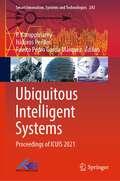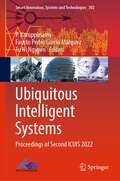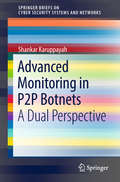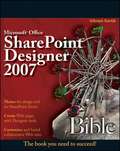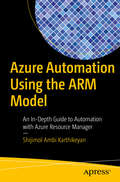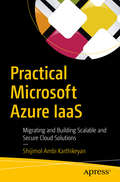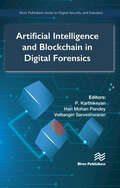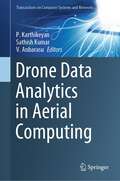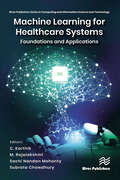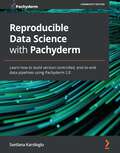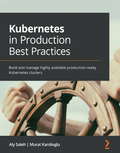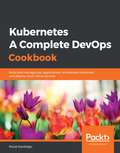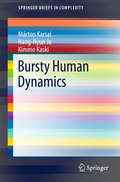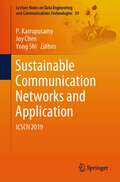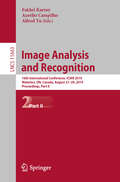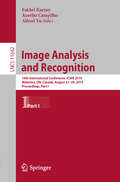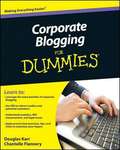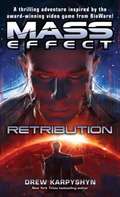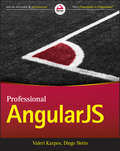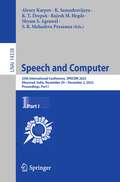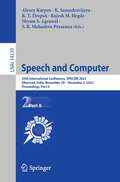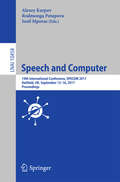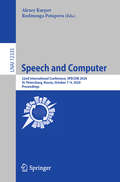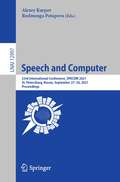- Table View
- List View
Ubiquitous Intelligent Systems: Proceedings of ICUIS 2021 (Smart Innovation, Systems and Technologies #243)
by P. Karuppusamy Isidoros Perikos Fausto Pedro García MárquezThis book features a collection of high-quality, peer-reviewed papers presented at International Conference on Ubiquitous Intelligent Systems (ICUIS 2021) organized by Shree Venkateshwara Hi-Tech Engineering College, Tamil Nadu, India, during April 16–17, 2021. The book covers topics such as cloud computing, mobile computing and networks, embedded computing frameworks, modeling and analysis of ubiquitous information systems, communication networking models, big data models and applications, ubiquitous information processing systems, next-generation ubiquitous networks and protocols, advanced intelligent systems, Internet of things, wireless communication and storage networks, intelligent information retrieval techniques, AI-based intelligent information visualization techniques, cognitive informatics, smart automation systems, healthcare informatics and bioinformatics models, security and privacy of intelligent information systems, and smart distributed information systems.
Ubiquitous Intelligent Systems: Proceedings of Second ICUIS 2022 (Smart Innovation, Systems and Technologies #302)
by P. Karuppusamy Fausto Pedro García Márquez Tu N. NguyenThis book features a collection of high-quality, peer-reviewed papers presented at the Second International Conference on Ubiquitous Intelligent Systems (ICUIS 2022) organized by Shree Venkateshwara Hi-Tech Engineering College, Tamil Nadu, India, during March 10–11, 2022. The book covers topics such as cloud computing, mobile computing and networks, embedded computing frameworks, modeling and analysis of ubiquitous information systems, communication networking models, big data models and applications, ubiquitous information processing systems, next-generation ubiquitous networks and protocols, advanced intelligent systems, Internet of Things, wireless communication and storage networks, intelligent information retrieval techniques, AI-based intelligent information visualization techniques, cognitive informatics, smart automation systems, health care informatics and bioinformatics models, security and privacy of intelligent information systems, and smart distributed information systems.
Advanced Monitoring in P2P Botnets: A Dual Perspective (SpringerBriefs On Cyber Security Systems And Networks)
by Shankar KaruppayahProvides a unique and fresh overview of recent botnet monitoring landscapes.<P><P> Adopts a dual-perspective approach that provides a fair judgment and analysis of the investigated topics within botnet monitoring.<P> Includes interesting, new findings on the characteristics and nature of the infected machines as well as the networks they belong to.<P> Illustrates real-world botnet data obtained from active botnets.<P> This book presents current research in the area of advanced monitoring in P2P botnets, and uses a dual-perspective approach to discuss aspects of botnet monitoring in-depth. First, from the perspective of a defender, e.g. researchers, it introduces advanced approaches to successfully monitor botnets, taking the presence of current botnet anti-monitoring mechanisms into consideration. Then, adopting a botmaster perspective to anticipate the advances in future botnets, it introduces advanced measures to detect and prevent monitoring activities. All the proposed methods were evaluated either using real-world data or in a simulation scenario. In addition to providing readers with an in-depth understanding of P2P botnets, the book also analyzes the implications of the various design choices of recent botnets for effectively monitoring them. It serves as an excellent introduction to new researchers and provides a useful review for specialists in the field.
Microsoft Office SharePoint Designer 2007 Bible
by Vikram KartikSharePoint Designer allows you to design your own collaborative systems and processes across your enterprises inside the SharePoint platform. This in-depth Bible takes you from the basics through advanced features of SharePoint Designer, from application development to ongoing management after the systems are in place. Written by a SharePoint Designer expert, this guide makes Designer accessible for newcomers but is also full of insight, tips, and techniques for veterans who want to improve their system designs and increase productivity.
Azure Automation Using the ARM Model: An In-Depth Guide to Automation with Azure Resource Manager
by Shijimol Ambi KarthikeyanFocus exclusively on the Azure Resource Manager (ARM) deployment model for Azure automation and gain in-depth knowledge of topics such as runbook authoring, different types of automation runbooks, and hybrid cloud automation. This book covers practical approaches to creating runbooks for multiple use cases, including operational tasks such as VM management and integration of Azure automation with infrastructure monitoring solutions, such as Operations Management Suite (OMS). Along the way you'll see how to use PowerShell in Azure automation and cover essentials including Azure automation security, source control integration, and runbook output streams. Finally, you learn about integrating Azure automation with Desired State Configuration (DSC) to include various cloud, on-premise, and hybrid scenarios. What You Will Learn #65533; Work with the building blocks of Azure automation #65533; Create different types of runbook #65533; Master hybrid cloud automation with ARM #65533; Implement cloud automation use cases with practical examples Who This Book Is For Infrastructure and cloud architects, cloud support engineers, and system administrators.
Practical Microsoft Azure IaaS: Migrating And Building Scalable And Secure Cloud Solutions
by Shijimol Ambi KarthikeyanAdopt Azure IaaS and migrate your on-premise infrastructure partially or fully to Azure. This book provides practical solutions by following Microsoft’s design and best practice guidelines for building highly available, scalable, and secure solution stacks using Microsoft Azure IaaS. The author starts by giving an overview of Azure IaaS and its components: you’ll see the new aspects of Azure Resource Manager, storage in IaaS, and Azure networking. As such, you’ll cover design considerations for migration and implementation of infrastructure services, giving you practical skills to apply to your own projects. The next part of the book takes you through the different components of Azure IaaS that need to be included in a resilient architecture and how to set up a highly available infrastructure in Azure. The author focuses on the tools available for Azure IaaS automated provisioning and the different performance monitoring and fine-tuning options available for the platform. Finally, you’ll gain practical skills in Azure security and implementing Azure architectures.After reading Practical Microsoft Azure IaaS, you will have learned how to map the familiar on-premise architecture components to their cloud infrastructure counterparts. This book provides a focused and practical approach to designing solutions to be hosted in Azure IaaS.What You Will LearnMap the key Azure components to familiar concepts in infrastructure, such as virtualization, storage provisioning, switching, and firewallsImplement Azure IaaS deployment architectures Design IaaS environments in line with the Microsoft recommended best practices for scalability, resiliency, availability, performance, and securityManage the operational aspects of hosted environments, leverage automation, and fine tune for optimal performanceWho This Book Is ForInfrastructure and solution architects with skills in on-premise infrastructure design who want to up-skill in Azure IaaS.
Artificial Intelligence and Blockchain in Digital Forensics (River Publishers Series in Digital Security and Forensics)
by P. Karthikeyan Hari Mohan Pandey Velliangiri SarveshwaranDigital forensics is the science of detecting evidence from digital media like a computer, smartphone, server, or network. It provides the forensic team with the most beneficial methods to solve confused digital-related cases. AI and blockchain can be applied to solve online predatory chat cases and photo forensics cases, provide network service evidence, custody of digital files in forensic medicine, and identify roots of data scavenging. The increased use of PCs and extensive use of internet access, have meant easy availability of hacking tools. Over the past two decades, improvements in the information technology landscape have made the collection, preservation, and analysis of digital evidence extremely important. The traditional tools for solving cybercrimes and preparing court cases are making investigations difficult. We can use AI and blockchain design frameworks to make the digital forensic process efficient and straightforward. AI features help determine the contents of a picture, detect spam email messages and recognize swatches of hard drives that could contain suspicious files. Blockchain-based lawful evidence management schemes can supervise the entire evidence flow of all of the court data. This book provides a wide-ranging overview of how AI and blockchain can be used to solve problems in digital forensics using advanced tools and applications available on the market.
Drone Data Analytics in Aerial Computing (Transactions on Computer Systems and Networks)
by P. Karthikeyan Sathish Kumar V. AnbarasuThis book discusses the latest research, theoretical, and experimental research innovations in drone data analytics in aerial computing. Drone data analytics guarantees that the right people have the correct data at their fingertips whenever they need it. The contents also discuss the challenges faced with drone data analytics, such as due to the high mobility of drones, aerial computing is significantly different from terrestrial computing. It also includes case studies from leading drone vendors. The book also focuses on the comparison of data management and security mechanisms in drone data analytics. This book is useful to those working in agriculture, mining, waste management, and defenses department.
Machine Learning for Healthcare Systems: Foundations and Applications (River Publishers Series in Computing and Information Science and Technology)
by C. Karthik M. Rajalakshmi Sachi Nandan Mohanty Subrata ChowdhuryThe introduction of digital technology in the healthcare industry is marked by ongoing difficulties with implementation and use. Slow progress has been made in unifying different healthcare systems, and much of the world still lacks a fully integrated healthcare system. The intrinsic complexity and development of human biology, as well as the differences across patients, have repeatedly demonstrated the significance of the human element in the diagnosis and treatment of illnesses. But as digital technology develops, healthcare providers will undoubtedly need to use it more and more to give patients the best treatment possible. The extensive use of machine learning in numerous industries, including healthcare, has been made possible by advancements in data technologies, including storage capacity, processing capability, and data transit speeds. The need for a personalized medicine or "precision medicine" approach to healthcare has been highlighted by current trends in medicine due to the complexity of providing effective healthcare to each individual. Personalized medicine aims to identify, forecast, and analyze diagnostic decisions using vast volumes of healthcare data so that doctors may then apply them to each unique patient. These data may include, but are not limited to, information on a person’s genes or family history, medical imaging data, drug combinations, patient health outcomes at the community level, and natural language processing of pre-existing medical documentation. This book provides various insights into machine learning techniques in healthcare system data and its analysis. Recent technological advancements in the healthcare system represent cutting-edge innovations and global research successes in performance modelling, analysis, and applications.
Reproducible Data Science with Pachyderm: Learn how to build version-controlled, end-to-end data pipelines using Pachyderm 2.0
by Svetlana KarsliogluCreate scalable and reliable data pipelines easily with PachydermKey FeaturesLearn how to build an enterprise-level reproducible data science platform with PachydermDeploy Pachyderm on cloud platforms such as AWS EKS, Google Kubernetes Engine, and Microsoft Azure Kubernetes ServiceIntegrate Pachyderm with other data science tools, such as Pachyderm NotebooksBook DescriptionPachyderm is an open source project that enables data scientists to run reproducible data pipelines and scale them to an enterprise level. This book will teach you how to implement Pachyderm to create collaborative data science workflows and reproduce your ML experiments at scale.You'll begin your journey by exploring the importance of data reproducibility and comparing different data science platforms. Next, you'll explore how Pachyderm fits into the picture and its significance, followed by learning how to install Pachyderm locally on your computer or a cloud platform of your choice. You'll then discover the architectural components and Pachyderm's main pipeline principles and concepts. The book demonstrates how to use Pachyderm components to create your first data pipeline and advances to cover common operations involving data, such as uploading data to and from Pachyderm to create more complex pipelines. Based on what you've learned, you'll develop an end-to-end ML workflow, before trying out the hyperparameter tuning technique and the different supported Pachyderm language clients. Finally, you'll learn how to use a SaaS version of Pachyderm with Pachyderm Notebooks.By the end of this book, you will learn all aspects of running your data pipelines in Pachyderm and manage them on a day-to-day basis.What you will learnUnderstand the importance of reproducible data science for enterpriseExplore the basics of Pachyderm, such as commits and branchesUpload data to and from PachydermImplement common pipeline operations in PachydermCreate a real-life example of hyperparameter tuning in PachydermCombine Pachyderm with Pachyderm language clients in Python and GoWho this book is forThis book is for new as well as experienced data scientists and machine learning engineers who want to build scalable infrastructures for their data science projects. Basic knowledge of Python programming and Kubernetes will be beneficial. Familiarity with Golang will be helpful.
Kubernetes in Production Best Practices: Build and manage highly available production-ready Kubernetes clusters
by Murat Karslioglu Aly SalehDesign, build, and operate scalable and reliable Kubernetes infrastructure for productionKey FeaturesImplement industry best practices to build and manage production-grade Kubernetes infrastructureLearn how to architect scalable Kubernetes clusters, harden container security, and fine-tune resource managementUnderstand, manage, and operate complex business workloads confidentlyBook DescriptionAlthough out-of-the-box solutions can help you to get a cluster up and running quickly, running a Kubernetes cluster that is optimized for production workloads is a challenge, especially for users with basic or intermediate knowledge. With detailed coverage of cloud industry standards and best practices for achieving scalability, availability, operational excellence, and cost optimization, this Kubernetes book is a blueprint for managing applications and services in production.You'll discover the most common way to deploy and operate Kubernetes clusters, which is to use a public cloud-managed service from AWS, Azure, or Google Cloud Platform (GCP). This book explores Amazon Elastic Kubernetes Service (Amazon EKS), the AWS-managed version of Kubernetes, for working through practical exercises. As you get to grips with implementation details specific to AWS and EKS, you'll understand the design concepts, implementation best practices, and configuration applicable to other cloud-managed services. Throughout the book, you'll also discover standard and cloud-agnostic tools, such as Terraform and Ansible, for provisioning and configuring infrastructure.By the end of this book, you'll be able to leverage Kubernetes to operate and manage your production environments confidently.What you will learnExplore different infrastructure architectures for Kubernetes deploymentImplement optimal open source and commercial storage management solutionsApply best practices for provisioning and configuring Kubernetes clusters, including infrastructure as code (IaC) and configuration as code (CAC)Configure the cluster networking plugin and core networking components to get the best out of themSecure your Kubernetes environment using the latest tools and best practicesDeploy core observability stacks, such as monitoring and logging, to fine-tune your infrastructureWho this book is forThis book is for cloud infrastructure experts, DevOps engineers, site reliability engineers, and engineering managers looking to design and operate Kubernetes infrastructure for production. Basic knowledge of Kubernetes, Terraform, Ansible, Linux, and AWS is needed to get the most out of this book.
Kubernetes - A Complete DevOps Cookbook: Build and manage your applications, orchestrate containers, and deploy cloud-native services
by Murat KarsliogluLeverage Kubernetes and container architecture to successfully run production-ready workloads Key Features Implement Kubernetes to orchestrate and scale applications proficiently Leverage the latest features of Kubernetes to resolve common as well as complex problems in a cloud-native environment Gain hands-on experience in securing, monitoring, and troubleshooting your application Book Description Kubernetes is a popular open source orchestration platform for managing containers in a cluster environment. With this Kubernetes cookbook, you'll learn how to implement Kubernetes using a recipe-based approach. The book will prepare you to create highly available Kubernetes clusters on multiple clouds such as Amazon Web Services (AWS), Google Cloud Platform (GCP), Azure, Alibaba, and on-premises data centers. Starting with recipes for installing and configuring Kubernetes instances, you'll discover how to work with Kubernetes clients, services, and key metadata. You'll then learn how to build continuous integration/continuous delivery (CI/CD) pipelines for your applications, and understand various methods to manage containers. As you advance, you'll delve into Kubernetes' integration with Docker and Jenkins, and even perform a batch process and configure data volumes. You'll get to grips with methods for scaling, security, monitoring, logging, and troubleshooting. Additionally, this book will take you through the latest updates in Kubernetes, including volume snapshots, creating high availability clusters with kops, running workload operators, new inclusions around kubectl and more. By the end of this book, you'll have developed the skills required to implement Kubernetes in production and manage containers proficiently. What you will learn Deploy cloud-native applications on Kubernetes Automate testing in the DevOps workflow Discover and troubleshoot common storage issues Dynamically scale containerized services to manage fluctuating traffic needs Understand how to monitor your containerized DevOps environment Build DevSecOps into CI/CD pipelines Who this book is for This Kubernetes book is for developers, IT professionals, and DevOps engineers and teams who want to use Kubernetes to manage, scale, and orchestrate applications in their organization. Basic understanding of Kubernetes and containerization is necessary.
Bursty Human Dynamics (SpringerBriefs in Complexity)
by Márton Karsai Hang-Hyun Jo Kimmo KaskiThis book provides a comprehensive overview on emergent bursty patterns in the dynamics of human behaviour. It presents common and alternative understanding of the investigated phenomena, and points out open questions worthy of further investigations. The book is structured as follows. In the introduction the authors discuss the motivation of the field, describe bursty phenomena in case of human behaviour, and relate it to other disciplines. The second chapter addresses the measures commonly used to characterise heterogeneous signals, bursty human dynamics, temporal paths, and correlated behaviour. These definitions are first introduced to set the basis for the discussion of the third chapter about the observations of bursty human patterns in the dynamics of individuals, dyadic interactions, and collective behaviour. The subsequent fourth chapter discusses the models of bursty human dynamics. Various mechanisms have been proposed about the source of the heterogeneities in human dynamics, which leads to the introduction of conceptually different modelling approaches. The authors address all of these perspectives objectively, highlight their strengths and shortcomings, and mention possible extensions to them. The fifth chapter addresses the effect of individual heterogeneous behaviour on collective dynamics. This question in particular has been investigated in various systems including spreading phenomena, random walks, and opinion formation dynamics. Here the main issues are whether burstiness speeds up or slows down the co-evolving processes, and how burstiness modifies time-dependent paths in the system that determine the spreading patterns of any kind of information or influence. Finally in the sixth chapter the authors end the review with a discussion and future perspectives. It is an ideal book for researchers and students who wish to enter the field of bursty human dynamics or want to expand their knowledge on such phenomena.
Sustainable Communication Networks and Application: ICSCN 2019 (Lecture Notes on Data Engineering and Communications Technologies #39)
by P. Karrupusamy Joy Chen Yong ShiThis book presents state-of-the-art theories and technologies and discusses developments in the two major fields: engineering and sustainable computing. In this modern era of information and communication technologies [ICT], there is a growing need for new sustainable and energy-efficient communication and networking technologies. The book highlights significant current and potential international research relating to theoretical and practical methods toward developing sustainable communication and networking technologies. In particular, it focuses on emerging technologies such as wireless communications, mobile networks, Internet of things [IoT], sustainability, and edge network models. The contributions cover a number of key research issues in software-defined networks, blockchain technologies, big data, edge/fog computing, computer vision, sentiment analysis, cryptography, energy-efficient systems, and cognitive platforms.
Image Analysis and Recognition: 16th International Conference, ICIAR 2019, Waterloo, ON, Canada, August 27–29, 2019, Proceedings, Part II (Lecture Notes in Computer Science #11663)
by Fakhri Karray Aurélio Campilho Alfred YuThis two-volume set LNCS 11662 and 11663 constitutes the refereed proceedings of the 16th International Conference on Image Analysis and Recognition, ICIAR 2019, held in Waterloo, ON, Canada, in August 2019. The 58 full papers presented together with 24 short and 2 poster papers were carefully reviewed and selected from 142 submissions. The papers are organized in the following topical sections: Image Processing; Image Analysis; Signal Processing Techniques for Ultrasound Tissue Characterization and Imaging in Complex Biological Media; Advances in Deep Learning; Deep Learning on the Edge; Recognition; Applications; Medical Imaging and Analysis Using Deep Learning and Machine Intelligence; Image Analysis and Recognition for Automotive Industry; Adaptive Methods for Ultrasound Beamforming and Motion Estimation.
Image Analysis and Recognition: 16th International Conference, ICIAR 2019, Waterloo, ON, Canada, August 27–29, 2019, Proceedings, Part I (Lecture Notes in Computer Science #11662)
by Fakhri Karray Aurélio Campilho Alfred YuThis two-volume set LNCS 11662 and 11663 constitutes the refereed proceedings of the 16th International Conference on Image Analysis and Recognition, ICIAR 2019, held in Waterloo, ON, Canada, in August 2019. The 58 full papers presented together with 24 short and 2 poster papers were carefully reviewed and selected from 142 submissions. The papers are organized in the following topical sections: Image Processing; Image Analysis; Signal Processing Techniques for Ultrasound Tissue Characterization and Imaging in Complex Biological Media; Advances in Deep Learning; Deep Learning on the Edge; Recognition; Applications; Medical Imaging and Analysis Using Deep Learning and Machine Intelligence; Image Analysis and Recognition for Automotive Industry; Adaptive Methods for Ultrasound Beamforming and Motion Estimation.
Corporate Blogging For Dummies
by Douglas Karr Chantelle FlanneryEstablish a successful corporate blog to reach your customers Corporate blogs require careful planning and attention to legal and corporate policies in order for them to be productive and effective. This fun, friendly, and practical guide walks you through using blogging as a first line of communication to customers and explains how to protect your company and employees through privacy, disclosure, and moderation policies. Blogging guru Douglas Karr demonstrates how blogs are an ideal way to offer a conversational and approachable relationship with customers. You'll discover how to prepare, execute, establish, and promote a corporate blogging strategy so that you can reap the rewards that corporate blogging offers. Shares best practices of corporate blogging, including tricks of the trade, what works, and traps to avoid Walks you through preparing a corporate blog, establishing a strategy, promoting that blog, and measuring its success Reviews the legalities involved with a corporate blog, such as disclaimers, terms of service, comment policies, libel and defamation, and more Features examples of successful blogging programs throughout the book Corporate Blogging For Dummies shows you how to establish a corporate blog in a safe, friendly, and successful manner.
Mass Effect™: Retribution
by Drew KarpyshynHumanity has reached the stars, joining the vast galactic community of alien species. But beyond the fringes of explored space lurk the Reapers, a race of sentient starships bent on "harvesting" the galaxy's organic species for their own dark purpose. The Illusive Man, leader of the pro-human black ops group Cerberus, is one of the few who know the truth about the Reapers. To ensure humanity's survival, he launches a desperate plan to uncover the enemy's strengths-and weaknesses-by studying someone implanted with modified Reaper technology. He knows the perfect subject for his horrific experiments: former Cerberus operative Paul Grayson, who wrested his daughter from the cabal's control with the help of Ascension project director Kahlee Sanders. But when Kahlee learns that Grayson is missing, she turns to the only person she can trust: Alliance war hero Captain David Anderson. Together they set out to find the secret Cerberus facility where Grayson is being held. But they aren't the only ones after him. And time is running out. As the experiments continue, the sinister Reaper technology twists Grayson's mind. The insidious whispers grow ever stronger in his head, threatening to take over his very identity and unleash the Reapers on an unsuspecting galaxy. This novel is based on a Mature-rated video game.
Disconnect: Facebook's Affective Bonds
by Tero KarppiAn urgent examination of the threat posed to social media by user disconnection, and the measures websites will take to prevent it No matter how pervasive and powerful social media websites become, users always have the option of disconnecting—right? Not exactly, as Tero Karppi reveals in this disquieting book. Pointing out that platforms like Facebook see disconnection as an existential threat—and have undertaken wide-ranging efforts to eliminate it—Karppi argues that users’ ability to control their digital lives is gradually dissipating. Taking a nonhumancentric approach, Karppi explores how modern social media platforms produce and position users within a system of coded relations and mechanisms of power. For Facebook, disconnection is an intense affective force. It is a problem of how to keep users engaged with the platform, but also one of keeping value, attention, and desires within the system. Karppi uses Facebook’s financial documents as a map to navigate how the platform sees its users. Facebook’s plans to connect the entire globe through satellites and drones illustrates the material webs woven to keep us connected. Karppi analyzes how Facebook’s interface limits the opportunity to opt-out—even continuing to engage users after their physical death. Showing how users have fought to take back their digital lives, Karppi chronicles responses like Web2.0 Suicide Machine, an art project dedicated to committing digital suicide. For Karppi, understanding social media connectivity comes from unbinding the bonds that stop people from leaving these platforms. Disconnection brings us to the limit of user policies, algorithmic control, and platform politics. Ultimately, Karppi’s focus on the difficulty of disconnection, rather than the ease of connection, reveals how social media has come to dominate human relations.
Professional AngularJS
by Valeri Karpov Diego NettoA comprehensive guide to AngularJS, Google's open-source client-side framework for app development. Most of the existing guides to AngularJS struggle to provide simple and understandable explanations for more advanced concepts. As a result, some developers who understand all the basic concepts of AngularJS struggle when it comes to building more complex real-world applications. Professional AngularJS provides a thorough understanding of AngularJS, covering everything from basic concepts, such as directives and data binding, to more advanced concepts like transclusion, build systems, and automated integration testing. In addition to explaining the features of AngularJS, this book distills real-world experience on how these features fit together to enable teams to work together more effectively in building extraordinary apps. Offers a more thorough and comprehensive approach to AngularJS Includes pointers to other advanced topics Lets you build a simple application from scratch, explaining basic building blocks along the way for quick hands-on learning
Speech and Computer: 25th International Conference, SPECOM 2023, Dharwad, India, November 29 – December 2, 2023, Proceedings, Part I (Lecture Notes in Computer Science #14338)
by Alexey Karpov K. Samudravijaya K. T. Deepak Rajesh M. Hegde Shyam S. Agrawal S. R. Mahadeva PrasannaThe two-volume proceedings set LNAI 14338 and 14339 constitutes the refereed proceedings of the 25th International Conference on Speech and Computer, SPECOM 2023, held in Dharwad, India, during November 29–December 2, 2023.The 94 papers included in these proceedings were carefully reviewed and selected from 174 submissions. They focus on all aspects of speech science and technology: automatic speech recognition; computational paralinguistics; digital signal processing; speech prosody; natural language processing; child speech processing; speech processing for medicine; industrial speech and language technology; speech technology for under-resourced languages; speech analysis and synthesis; speaker and language identification, verification and diarization.
Speech and Computer: 25th International Conference, SPECOM 2023, Dharwad, India, November 29 – December 2, 2023, Proceedings, Part II (Lecture Notes in Computer Science #14339)
by Alexey Karpov K. Samudravijaya K. T. Deepak Rajesh M. Hegde Shyam S. Agrawal S. R. Mahadeva PrasannaThe two-volume proceedings set LNAI 14338 and 14339 constitutes the refereed proceedings of the 25th International Conference on Speech and Computer, SPECOM 2023, held in Dharwad, India, during November 29–December 2, 2023.The 94 papers included in these proceedings were carefully reviewed and selected from 174 submissions. They focus on all aspects of speech science and technology: automatic speech recognition; computational paralinguistics; digital signal processing; speech prosody; natural language processing; child speech processing; speech processing for medicine; industrial speech and language technology; speech technology for under-resourced languages; speech analysis and synthesis; speaker and language identification, verification and diarization.
Speech and Computer
by Alexey Karpov Rodmonga Potapova Iosif MporasThis book constitutes the refereed proceedings of the 16th International Conference on Speech and Computer, SPECOM 2014, held in Novi Sad, Serbia. The 56 revised full papers presented together with 3 invited talks were carefully reviewed and selected from 100 initial submissions. It is a conference with long tradition that attracts researchers in the area of computer speech processing (recognition, synthesis, understanding etc. ) and related domains (including signal processing, language and text processing, multi-modal speech processing or human-computer interaction for instance).
Speech and Computer: 22nd International Conference, SPECOM 2020, St. Petersburg, Russia, October 7–9, 2020, Proceedings (Lecture Notes in Computer Science #12335)
by Alexey Karpov Rodmonga PotapovaThis book constitutes the proceedings of the 22nd International Conference on Speech and Computer, SPECOM 2020, held in St. Petersburg, Russia, in October 2020. The 65 papers presented were carefully reviewed and selected from 160 submissions. The papers present current research in the area of computer speech processing including speech science, speech technology, natural language processing, human-computer interaction, language identification, multimedia processing, human-machine interaction, deep learning for audio processing, computational paralinguistics, affective computing, speech and language resources, speech translation systems, text mining and sentiment analysis, voice assistants, etc.Due to the Corona pandemic SPECOM 2020 was held as a virtual event.
Speech and Computer: 23rd International Conference, SPECOM 2021, St. Petersburg, Russia, September 27–30, 2021, Proceedings (Lecture Notes in Computer Science #12997)
by Alexey Karpov Rodmonga PotapovaThis book constitutes the proceedings of the 23rd International Conference on Speech and Computer, SPECOM 2021, held in St. Petersburg, Russia, in September 2021.* The 74 papers presented were carefully reviewed and selected from 163 submissions. The papers present current research in the area of computer speech processing including audio signal processing, automatic speech recognition, speaker recognition, computational paralinguistics, speech synthesis, sign language and multimodal processing, and speech and language resources.*Due to the COVID-19 pandemic, SPECOM 2021 was held as a hybrid event.
